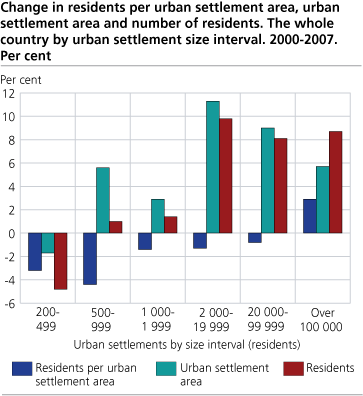Content
Published:
This is an archived release.
Large in-migration to urban settlements
In 2006 about 21 500 more people moved to urban settlements than those who moved out. In the same period the excess of births in urban settlements was about 15 000 people and in addition about 11 000 on the basis of expansion of urban settlements.
The population in urban settlements increased with a total of 47 500 people in 2006. That brings the total number of dwellers in urban settlements up to 3 655 391 in altogether 917 urban settlements in Norway as of 1. January 2007. 78.3 per cent of the population of Norway lives in urban settlements.
Large excess of births in urban settlements
As much as 86 per cent of the excess of births in Norway are linked to urban settlements. The urban settlements in the counties Akershus, Oslo, Rogaland, Hordaland and Sør-Trøndelag had all an excess of births of more than 1 000, and Oslo at the top with nearly 5 000.
Migrationflows go to densely populated areas
In 2006 the net migration in Norway was about 24 000. As much as 90 per cent, 21 500, of the net migration took place in urban settlements. The counties Akershus, Oslo and Rogaland had a net migration of more than 3 000, and Oslo at the top with a net migration of nearly 6 000.
Fewer inhabitants in sparsely populated areas
Despite both excess of births and net in-migration in sparsely populated areas, the number of inhabitants was reduced with almost 5 000 in 2006. The reason for this was that nearly 9 000 people exceeded from living in sparsely populated areas to living in an urban settlement owing to changes in the boundaries of urban settlements.
| Residents in and areas of urban settlements, by population size |
| 2007 | Change from 2006 to 2007 | ||||||||||||||||||||||||||||||||||||||
|---|---|---|---|---|---|---|---|---|---|---|---|---|---|---|---|---|---|---|---|---|---|---|---|---|---|---|---|---|---|---|---|---|---|---|---|---|---|---|---|
| Residents | Area. km2 |
Number of
urban settlements |
Residents | Area. km2 |
Number of
urban settlements |
||||||||||||||||||||||||||||||||||
| Total | 3 655 391 | 2 294.08 | 917 | 47 578 | 30.98 | 12 | |||||||||||||||||||||||||||||||||
| 200-499 residents | 116 587 | 167.01 | 340 | 1 675 | 4.21 | 10 | |||||||||||||||||||||||||||||||||
| 500-999 residents | 153 005 | 190.12 | 220 | -1 612 | 1.63 | -1 | |||||||||||||||||||||||||||||||||
| 1 000-1 999 residents | 207 397 | 210.66 | 147 | -374 | 0.74 | 1 | |||||||||||||||||||||||||||||||||
| 2 000-19 999 residents | 1 031 895 | 773.67 | 191 | 11 105 | 12.28 | 2 | |||||||||||||||||||||||||||||||||
| 20 000-99 999 residents | 752 541 | 442.06 | 15 | 13 341 | 7.98 | - | |||||||||||||||||||||||||||||||||
| 100 000 or more residents | 1 393 966 | 510.56 | 4 | 23 443 | 4.14 | - | |||||||||||||||||||||||||||||||||
Highest increase in the largest urban settlements
In 2006 the growth in the 19 urban settlements with 20 000 inhabitants or more was about 37 000, or 77 per cent of the total population growth in urban settlements. The area increased at the same time with about 12 km2, or just below 40 per cent of the total changes in the area of urban settlement.
The number of urban settlements in 2006 increased with 12. 15 new urban settlements have been established, 2 urban settlements have been omitted and one urban settlement has been merged with an other urban settlement.
The high increase in land area covered by urban settlements continues
In total 2 294 km2 of the land area in Norway was urban settlements as of 1. January 2007. The urban settlements area increased by nearly 30 km2 in 2006, or 1.4 per cent.
The population density for urban settlements in Norway is averaged to 1 593 as of 1. January 2007. The population density has risen slightly, compared to figures as of 1. January 2000, when the population density for urban settlements was 1 588.
If one break down the urban settlement figures by size intervals differences appear. The smallest of all urban settlements have most declines in residents in such a way that the population density has dropped slightly. The somewhat larger urban settlements have experienced an increase in residents and area, but the increase has been largest in area in such a way that the density has been reduced slightly. The very largest urban settlements have had largest growth in residents in such a way that the population density has risen. Altogether the changes in population density in urban settlements have been little.
|
Changes in area and population through the years can to some degree be due to delay and changed register routines, particularly for smaller urban settlements and municipalities. Changes by size interval are also the result of changes in the number of urban settlements. Among other can less densely populated urban settlements get more people and thus be transferred to the size interval above, or urban settlements can disappear. |
Tables:
- Table 1 Urban settlements. Population and area, by municipality. 1 January 2007
- Table 2 Population and area in urban settlements. Municipality. 1 January 2007
- Table 3 Population per 1 January 2007 and population changes in 2006 in densely and sparsely populated areas.
- Table 4 New and omitted urban settlements. 1 January 2007
Contact
-
Even Høydahl
E-mail: even.hoydahl@ssb.no
tel.: (+47) 95 77 79 06
-
Dana Moe
E-mail: dana.moe@ssb.no
tel.: (+47) 99 85 23 42
-
Vilni Verner Holst Bloch
E-mail: vilni.verner.holst.bloch@ssb.no
tel.: (+47) 94 82 25 32
-
Statistics Norway's Information Centre
E-mail: informasjon@ssb.no
tel.: (+47) 21 09 46 42

